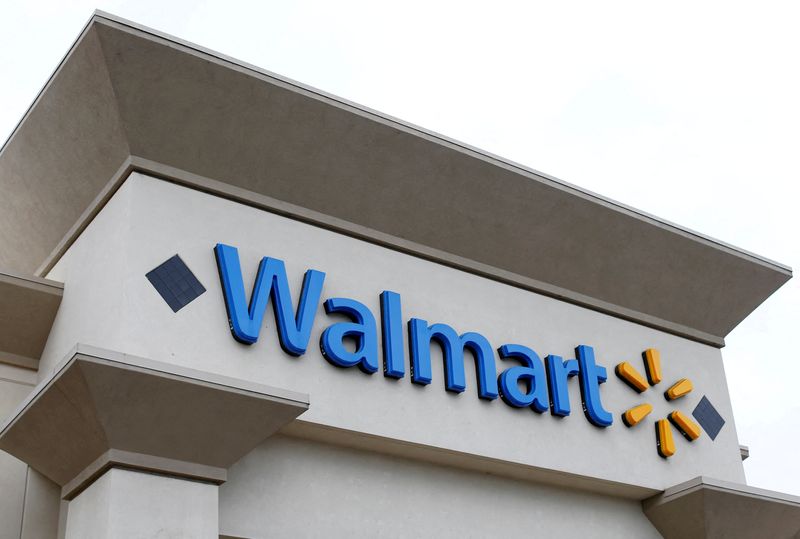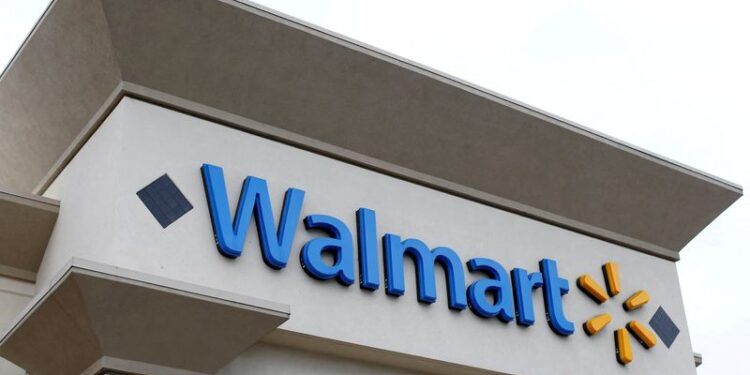By Ananya Mariam Rajesh
(Reuters) -Walmart on Tuesday raised its annual sales and profit forecast for the third consecutive time, with people buying more groceries and merchandise online and at its stores, a sign that it may be gaining market share ahead of the holiday season.
Shares of Walmart (NYSE:), which are up nearly 60% this year, rose about 4% in premarket trading on Tuesday.
The retailer is among the first major U.S. chains to provide insight into the all-important holiday quarter and how consumers are planning to spend as inflation ebbs.
“In the U.S., in-store volumes grew, pickup from store grew faster, and delivery from store grew even faster than that,” Walmart CEO Doug McMillon said.
Though inflation has not made much headway in recent months, it is on a downward trend, raising purchasing power. Walmart said it saw share gains across income cohorts mainly led by upper-income households, which make more than $100,000 in annual income.
The retail bellwether now forecast fiscal 2025 consolidated net sales to rise in the range of 4.8% to 5.1%, compared with prior expectations of 3.75% to 4.75% growth.
It also expects annual adjusted profit per share to be between $2.42 and $2.47, compared with its previous forecast of $2.35 and $2.43.
Retailers including Walmart, Amazon.com (NASDAQ:) and Target (NYSE:) kicked off the holiday shopping season earlier than usual, offering deals on everything from toys to household items.
Walmart and Target stocked more private-label brands and upped their grocery offerings as consumers seek to purchase essentials and gifts at the lowest price possible.
“The majority of our customers are maintaining their holiday plans year over year amidst the election, the calendar shift, the economic backdrop,” Walmart said.
Republican Donald Trump’s victory in the 2024 U.S. presidential election could weigh on some shoppers, said Minkyung Kim, Assistant Professor of Marketing at Carnegie Mellon University’s Tepper School of Business.
Trump’s tariffs on imports, if implemented in 2025, could raise prices on clothing, toys, furniture, appliances, footwear, and travel goods, particularly affecting items where China is a major supplier, according to the National Retail (NYSE:) Federation, a U.S. trade group of which Walmart’s U.S. head is the chair.
“We’ve been living under a tariff environment for seven years, so we’re pretty familiar with that,” CFO John David Rainey said in an interview with CNBC.
“Tariffs, though, are inflationary for customers, so we want to work with suppliers and with our own private brand assortment to try to bring down prices.”
MORE PURCHASING POWER
In the third quarter ended Oct. 31, Walmart’s U.S. comparable sales rose 5.3%, beating analysts estimates of a 3.61% increase, according to data compiled by LSEG. It saw sales growth across categories including the general merchandise segment that had suffered declines for over two years due to sticky inflation.
Walmart also posted comparable sales growth in its health and wellness category, helped by strong demand for GLP-1 or weight-loss drugs.
As purchasing power increases, analysts expect upper and middle income consumers to mainly drive the shift back in spending on non-essential, nice-to-have merchandise.
The company has invested billions on automation in its supply chain to help stock fresher produce and improve delivery times as consumers increasingly prefer the convenience of purchasing groceries online.
To broaden the appeal of its delivery service, Walmart slashed the annual fee for its Walmart Plus membership, by 50% ahead of the holiday season. Walmart Plus members receive unlimited free same-day deliveries from stores on orders over $35.
The retailer said in the third quarter total e-commerce sales rose 27%, compared to the 21% in the prior quarter.

“I do think Walmart has been capturing a more affluent consumer. I think the Walmart Plus membership has helped drive that and the company continues to reflect good strength in their online business and their pick up and delivery,” Telsey Advisory Group analyst Joseph Feldman said.
The retailer reported quarterly adjusted profit of 58 cents per share. Analysts were expecting 53 cents per share.







